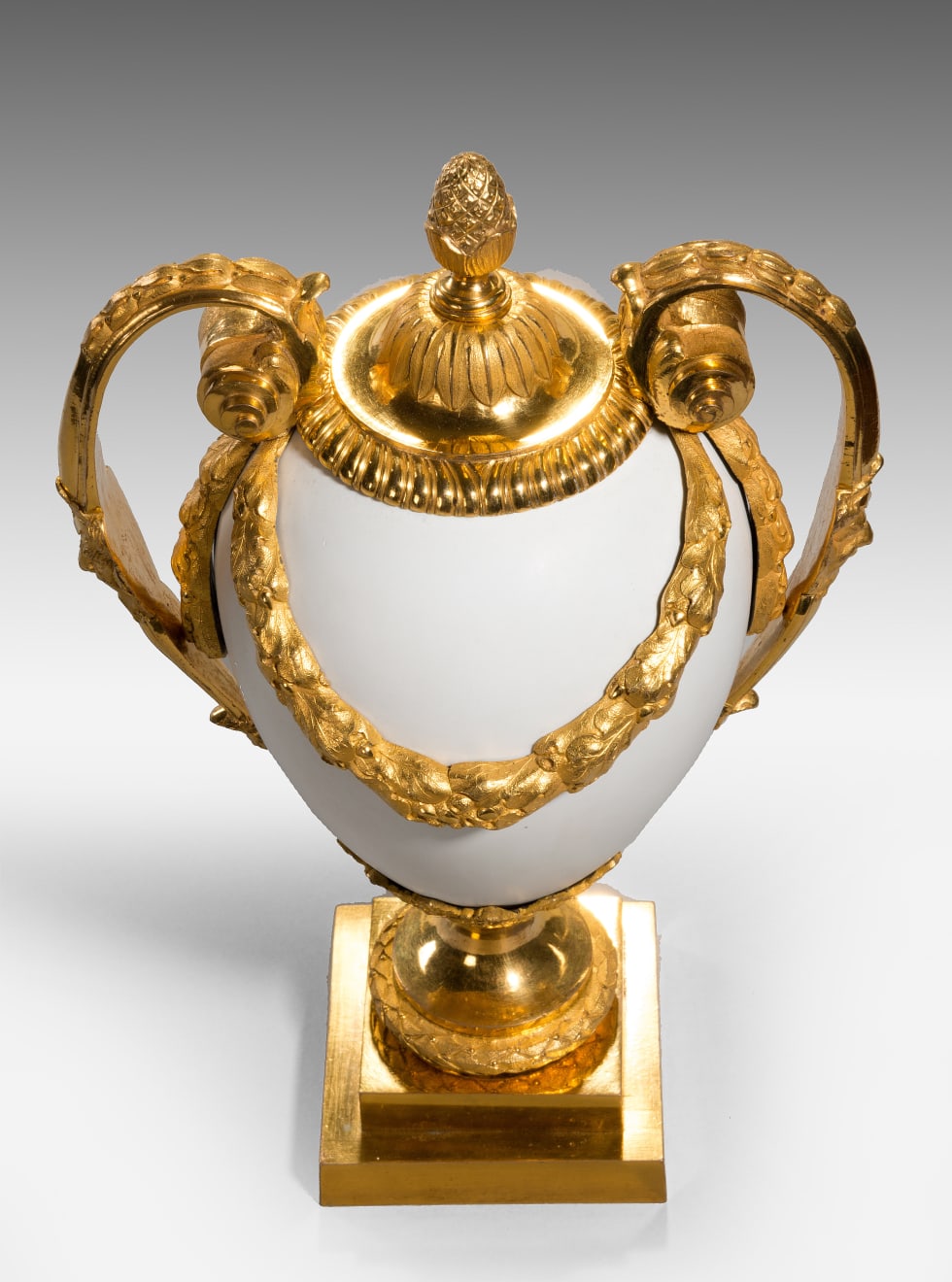George III Opaque Glass Ormolu-Mounted Vase by Matthew Boulton
White opaque glass by James Keir
ENGLAND, circa 1770
28 x 18.5 x 15 cm
Further images
An ornamental vase, with a pine cone finial, leaf motif, gadrooned rim, oak-leaf swags and pendants on the body. With satyr’s masks on the handles, which are topped with an elegant voluted scroll. The vase conforms to the sketch numbered 1241 in the pattern books (Nicholas Goodison, Matthew Boulton: ORMOLU, London, 2002, p.311, plate 294).
Nicholas Goodison explains that although blue john took a prominent role in Matthew Boulton’s plans for 1769, it was only one of several materials which Boulton considered suitable for the bodies of his vases. He wrote a list of suitable vase bodies that year, which included: ‘Glass blew and other colours’. (Nicholas Goodison, Matthew Boulton: ORMOLU, London, 2002, p.48). Goodison writes of Boulton’s vases: ‘Coloured glass was used occasionally’ and notes that: ‘Several of the other vase bodies were bought from specialist producers… [He] ordered twenty-four glass vases from James Keir in 1772, twelve in each of two moulds. Some of these white glass bodies were probably for the wing-figured vases… Others could have been for the glass versions of the vases with satyr masks on their handles… [A] year later Keir’s firm was asked to supply three pairs of white opaque glass bodies to the dimensions of a drawing appended to the letter, and another three to the dimensions of a drawing send two months earlier. Boulton and Fothergill were anxious that these should be round, ‘for if they have any flat places in them they will be of no use because we turn the surface of in a lathe besides the work will not fit nor do they look so well’. This letter adds to the evidence in the archives that the vases had to be made to fit the pre-designed mounts and that some re-working of the vase bodies was carried out at Soho.’ (p.48 and p.151)
Matthew Boulton (3 September 1728 – 17 August 1809): was an English manufacturer and business partner of the Scottish engineer, James Watt. Born in Birmingham, he was the son of a Birmingham buckle-, button- and ‘toy’-maker. His father died when Boulton was 31 but, by then, Boulton had managed the business for several years, and expanded it considerably, consolidating operations at the Soho Manufactory. At Soho, he adopted the latest techniques, branching into silver plate, ormolu and other decorative arts. He became associated with James Watt when Watt’s business partner, John Roebuck, was unable to pay a debt to Boulton, who accepted Roebuck’s share of Watt’s patent as settlement. He then successfully lobbied Parliament to extend Watt’s patent for an additional 17 years, enabling the firm to market Watt’s steam engine. The firm installed hundreds of Boulton & Watt steam engines in Britain and abroad, initially in mines and then in factories.
Boulton was a key member of the Lunar Society, whose members included Watt, Erasmus Darwin, Josiah Wedgwood and Joseph Priestley. Boulton founded the Soho Mint, to which he soon adapted steam power. He sought to improve the poor state of Britain’s coinage, and after several years of effort obtained a contract in 1797 to produce the first British copper coinage in a quarter century. His “cartwheel” pieces were well-designed and difficult to counterfeit, and included the first striking of the large copper British penny, which continued to be coined until decimalisation in 1971. He retired in 1800, though continuing to run his mint, and died in 1809. His image appears alongside James Watt on the Bank of England’s new Series F £50 note.
James Keir (20 September 1735 – 11 October 1820): was a Scottish chemist, geologist, industrialist, and inventor, and an important member of the Birmingham Lunar Society. In 1772, a group including Keir leased a long-established glassworks at Amblecote near Stourbridge, which he managed. His partners in this venture included Samuel Skey, who manufactured vitriol near Bewdley, and John Taylor, a leading Birmingham manufacturer. Whilst he was there, Keir continued his chemical experiments, particularly into the properties of alkalis. He wrote a paper ‘On the Crystallisations observed on Glass’, which was given to the Royal Society by his friend George Fordyce and printed in the Society’s ‘Philosophical Transactions’ in 1776. In 1777, he issued a ‘Treatise on the Different kinds of Elastic Fluids or Gases’. Keir became friends with Matthew Boulton, and, in the autumn of 1768 he first met James Watt at Boulton’s house. He was subsequently commissioned by Boulton to produce glass bodies for vases and, being an able businessman and an accomplished scientist, Boulton turned to him for advice on several occasions. In Matthew Boulton: ORMOLU, Goodison notes that Keir: ‘was offered a partnership by Boulton and Fothergill but declined’ (p.48).






